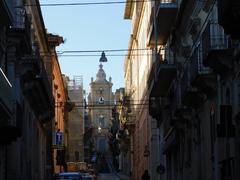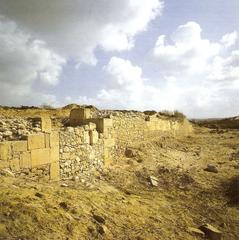Sant’Agata Ragusa Visiting Hours, Tickets, and Historical Sites Guide
Date: 14/06/2025
Introduction: Sant’Agata’s Enduring Heritage
Sant’Agata is a name woven through Italy’s rich historical and cultural tapestry, most notably associated with the Church of Sant’Agata ai Cappuccini in Ragusa, Sicily, and the picturesque hilltop village of Sant’Agata sui Due Golfi on the Sorrento Peninsula. This guide offers travelers a detailed look into Sant’Agata’s diverse legacy, combining essential visiting information with deep historical context, recommendations for local events and cuisine, and practical travel tips for an unforgettable journey.
The Church of Sant’Agata ai Cappuccini, nestled in Ragusa’s Giardini Iblei, stands as a beacon of Baroque artistry and faith, its origins stretching back to 1308. Restored after the catastrophic 1693 earthquake and home to Pietro Novelli’s renowned triptych, the church is integral to Ragusa’s UNESCO-listed Baroque cityscape (tscrestauri.com, theworldofsicily.com). Ragusa itself, with its Ibla and Superiore districts, is a living museum of Baroque architecture, vibrant festivals, and a celebrated culinary tradition.
Meanwhile, Sant’Agata sui Due Golfi offers a tranquil escape with panoramic views, echoing Roman roots and traditional Campanian culture. Its strategic location makes it an ideal base for exploring the Amalfi Coast, Sorrento, and beyond (Positano.com, Lonely Planet).
This comprehensive guide is designed to equip visitors with everything needed to explore Sant’Agata and Ragusa’s historical treasures, plan around visiting hours and ticketing, enjoy local festivals and gastronomy, and make the most of their time in these captivating Italian destinations. For real-time updates and exclusive content, consider the Audiala app and official tourism resources (ragusaturismo.it).
Table of Contents
- Introduction: Sant’Agata’s Enduring Heritage
- Sant’Agata ai Cappuccini, Ragusa
- Ragusa: Architectural and Natural Highlights
- Festivals, Events, and Gastronomy in Sant’Agata & Ragusa
- Sant’Agata sui Due Golfi: Visitor Guide
- Summary and Key Takeaways
- References and Further Reading
Sant’Agata ai Cappuccini, Ragusa: History and Visitor Essentials
Origins and Early History
The Church of Sant’Agata ai Cappuccini traces its roots to 1308, with historical records marking its presence in Ragusa’s spiritual landscape (tscrestauri.com). Set at the eastern edge of the tranquil Giardini Iblei, it became a center of devotion and community through the centuries.
Capuchin Friars and Transformation
Capuchin friars, dedicated to service and humility, arrived in Ragusa in 1537. After acquiring Sant’Agata in 1603, they transformed both the church and its adjoining convent, with major works completed by 1610 (tscrestauri.com, theworldofsicily.com). These renovations established the structures seen today, marked by inscriptions commemorating each phase.
1693 Earthquake and Baroque Rebirth
The devastating 1693 earthquake left much of southeastern Sicily in ruins. Sant’Agata ai Cappuccini, heavily damaged, was rebuilt in the exuberant Baroque style that defines Ragusa Ibla’s UNESCO status as a “Late Baroque Town of the Val di Noto” (theworldofsicily.com).
Artistic Masterpieces: Novelli’s Triptych
The church’s most celebrated artwork is Pietro Novelli’s 17th-century triptych, featuring the Assumption of the Virgin, scenes of St. Agatha’s and St. Catherine’s martyrdoms, and—by tradition—a self-portrait of the artist among the apostles (theworldofsicily.com).
Modern Restorations and Adaptive Reuse
After periods of decline, especially post-1861 and in the late 20th century, restoration campaigns in the 1980s and 2015–2016 preserved the church’s wooden architecture and artworks (tscrestauri.com). The former convent now thrives as the Nosco School of Culinary Arts, the Cenobio Restaurant, and a boutique hotel, blending historic ambiance with contemporary Sicilian hospitality (theworldofsicily.com).
Visiting Hours, Tickets, and Accessibility
- Visiting Hours: Generally open 9:00 AM–1:00 PM and 3:00 PM–6:00 PM daily; check locally for holiday variations.
- Tickets: Free entry; guided tours and special exhibits may require a fee (inquire at the site or via ragusaturismo.it).
- Accessibility: Partially accessible for reduced mobility; some areas have steps or uneven floors. On-site assistance available.
- Guided Tours: Offered by local operators and the tourism office, focusing on history and art.
Nearby Attractions in Ragusa Ibla
Within walking distance: the Cathedral of San Giorgio, Palazzo Arezzo di Donnafugata, and Circolo di Conversazione. Giardino Ibleo’s shaded paths and panoramic viewpoints are ideal for relaxation and photos.
FAQ: Visiting Sant’Agata ai Cappuccini
Q: What are the visiting hours?
A: 9:00 AM–1:00 PM and 3:00 PM–6:00 PM daily; check for holiday changes.
Q: Is there an entrance fee?
A: Entry is free. Guided tours or special events may require tickets.
Q: Is the church accessible?
A: Partially; assistance is available on request.
Q: Are guided tours offered?
A: Yes, through local agencies and the tourism office.
Q: Can I take photos?
A: Generally allowed without flash; confirm on-site.
Ragusa: Architectural and Natural Highlights
Ragusa Ibla: Baroque Masterpiece
Ragusa Ibla is a labyrinth of Baroque churches and palazzi, rebuilt after 1693 and now part of a UNESCO World Heritage Site (Eternal Arrival).
- Duomo di San Giorgio: Neoclassical dome, ornate façade, open daily 9:00 AM–7:00 PM; free entry, paid guided tours available.
- Chiesa delle Santissime Anime del Purgatorio: Known for its staircase and Baroque details.
- Portale di San Giorgio: Surviving Gothic portal revealing medieval Ragusa.
Ragusa Superiore: Modern Elegance
A grid-like district with grand boulevards and the Cathedral of San Giovanni Battista (open 8:30 AM–12:30 PM, 4:00 PM–7:00 PM). Climb the bell tower (ticketed) for panoramic city views (Eternal Arrival).
Gardens and Viewpoints
- Giardino Ibleo: 19th-century gardens with palm trees, fountains, and the Church of San Giacomo Apostolo (Eternal Arrival).
- Mirador de Ragusa Ibla & Panoramica su Ragusa: Top spots for cityscape photos, especially at sunset.
Outdoor Activities
- Irminio River Nature Reserve: Trails for hiking and birdwatching (Tourist Secrets).
- Nearby Beaches: Marina di Ragusa and Punta Secca.
- Golf: Donnafugata Golf Resort.
Cultural and Culinary Experiences
Explore palazzi, museums, and artisan workshops. Enjoy local cheeses, wines, and cooking classes (Eternal Arrival).
Practical Travel Tips
- Best Time: May–June and September–October.
- Getting Around: Ibla is pedestrian-friendly; car rental is useful for countryside trips.
- Accommodations: Boutique hotels, historic inns, and luxury resorts.
- Accessibility: Ibla’s cobblestones may challenge mobility; Superiore is more accessible.
Festivals, Events, and Gastronomy in Sant’Agata & Ragusa
Major Festivals and Religious Events
- Festa di San Giovanni Battista: June 15–24, with processions and fireworks (Enjoy Sicilia).
- Festa di San Giorgio: Last Sunday in May, featuring elaborate parades and extended site hours (My Guide Sicily).
- Ibla Buskers Festival: October 10–13, street performances in Ragusa Ibla.
Food and Wine Festivals
- Cherry Festival (Monterosso Almo)
- Truffle Market Fair (Chiaramonte Gulfi)
- Seasoned Bread Festival (Pozzallo) Check Enjoy Sicilia for current schedules and ticketing.
Local Gastronomy
- Signature Dishes: Pasta alla Norma, arancini, scaccia, pastieri, cunnighiu a partuisa.
- Cheeses & Cured Meats: Caciocavallo Ragusano, Provolone del Monaco.
- Sweets: Modica’s chocolate, almond pastries.
- Wines & Olive Oil: Falanghina del Sannio, Cerasuolo di Vittoria, and local EVOO.
- Recommended Eateries: Panificio Giummarra, Agli Archi, Gelati DiVini, Salumeria Barocco, Cantunera.
Cooking Classes and Food Tours
Hands-on experiences with market visits are offered by local guides (Go Ask a Local).
Festival & Gastronomy Visitor Tips
- Timing: Spring and autumn for best weather and events.
- Accommodation: Book early during festivals.
- Etiquette: Dress modestly for religious events; join communal meals for cultural immersion.
Festival & Food FAQs
Q: What are typical visiting hours for historical sites?
A: 9:00 AM–6:00 PM; check for holiday changes.
Q: Are festival events ticketed?
A: Religious events are free; some museums or reenactments require tickets.
Q: Are cooking classes available?
A: Yes, in both Sant’Agata and Ragusa.
Sant’Agata sui Due Golfi: Complete Visitor Guide
History and Significance
A village with Roman origins and a unique vantage point over both the Gulf of Naples and Salerno. Notable for its Church of Sant’Agata and rural architecture (Positano.com, Lonely Planet).
Getting There
- By Air: Naples International Airport; train to Sorrento, then SITA bus or taxi.
- By Train: Circumvesuviana to Sorrento, then local bus.
- By Bus: SITA buses connect with Sorrento, Massa Lubrense, and Amalfi.
- By Car: Via Nastro Azzurro/Verde; parking is limited.
- Taxi/Private Transfer: Convenient but more expensive.
Visiting Hours, Tickets, and Tours
As a living village, Sant’Agata sui Due Golfi has no general entrance fee. The Church of Sant’Agata is usually open from 9:00 AM–6:00 PM. Book guided tours for in-depth experiences.
Getting Around
- On Foot: Ideal for exploring steep, scenic streets.
- Local Buses: SITA network for area travel.
- Car/Scooter Rental: Available in Sorrento; parking is limited.
Best Photographic Spots
Hilltop terraces, the church square, and panoramic paths offer superb views of both gulfs and Capri.
Practical Tips
- Best Time: April–June, September–October.
- Accommodation: Ranges from boutique hotels to agriturismi; Don Alfonso 1890 is a local highlight.
- Dining: Local specialties include Sant Anna tomatoes, lemons, and Monti Lattari cheese.
- Accessibility: Steep streets may challenge those with mobility issues.
- Parking: Accommodations often provide private lots; public parking is limited.
Excursions and Activities
Easy access to Sorrento, Positano, Amalfi, and Pompeii. Top hiking routes include the Path of the Gods (EasyJet).
FAQs
Q: Do I need tickets to visit the village?
A: No general entry fee; specific sites or tours may require tickets.
Q: Is Sant’Agata sui Due Golfi accessible?
A: Accessibility is limited; check with accommodations for options.
Summary & Key Takeaways
Sant’Agata, whether in Ragusa or overlooking the dual gulfs of Campania, is a destination of deep historical, artistic, and natural significance. In Ragusa, the Church of Sant’Agata ai Cappuccini exemplifies centuries of faith and Baroque splendor, supported by vibrant festivals, world-class cuisine, and a welcoming community (tscrestauri.com, theworldofsicily.com, Enjoy Sicilia). Sant’Agata sui Due Golfi enchants with panoramic vistas, traditional hospitality, and ready access to the Amalfi Coast (Positano.com, Lonely Planet).
Understanding visiting hours, ticketing, accessibility, and local customs will ensure your journey is smooth and rewarding. Enhance your experience with guided tours, culinary adventures, and digital travel tools like Audiala.
Visuals and Media Suggestions
- Include high-resolution images of the Church of Sant’Agata ai Cappuccini, Ragusa Ibla at sunset, festival processions, and panoramic views from Sant’Agata sui Due Golfi.
- Recommended alt tags: “Baroque façade of Duomo di San Giorgio, Ragusa,” “Sunset over Ragusa Ibla,” “Street performers at Ibla Buskers Festival,” “Panoramic view from Sant’Agata sui Due Golfi terrace.”
Internal and External Links
- Ragusa historical sites
- Late Baroque Towns of Val di Noto
- Ragusa Official Tourism
- Church Restoration Project
- Enjoy Sicilia Festivals
- Positano.com: Sant’Agata sui Due Golfi
References and Further Reading
- tscrestauri.com
- theworldofsicily.com
- Eternal Arrival
- Enjoy Sicilia
- Positano.com
- Lonely Planet
- EasyJet
- IslaGuru
- ragusaturismo.it
- Audiala
Plan your visit to Sant’Agata and Ragusa, immerse yourself in their living traditions and stunning landscapes, and let your journey be guided by the best information and insider tips available. For up-to-date events, ticketing, and digital guides, download the Audiala app and follow official tourism channels.

